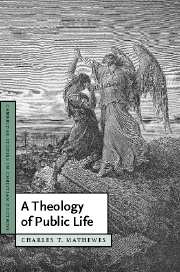Book contents
- Frontmatter
- Contents
- Acknowledgments
- List of abbreviations for works by St. Augustine
- Introduction: Life in the epilogue, during the world
- Part I A theology of engagement
- Part II The liturgy of citizenship
- Introduction to Part II
- 4 Faithful citizenship
- 5 Hopeful citizenship
- 6 Charitable citizenship
- Conclusion: The republic of grace; or, the public ramifications of heaven
- List of references
- Index
Introduction to Part II
Published online by Cambridge University Press: 05 June 2012
- Frontmatter
- Contents
- Acknowledgments
- List of abbreviations for works by St. Augustine
- Introduction: Life in the epilogue, during the world
- Part I A theology of engagement
- Part II The liturgy of citizenship
- Introduction to Part II
- 4 Faithful citizenship
- 5 Hopeful citizenship
- 6 Charitable citizenship
- Conclusion: The republic of grace; or, the public ramifications of heaven
- List of references
- Index
Summary
Part I offered an Augustinian theology of engagement: a proposal that sees the human's basic desire to be one of ever deepening communion with God, a communion that is realized, in this world, not through a sinful detachment from the world, but rather through a proper engagement with it. Indeed, the fundamental human fault is nothing other than such escapism – detachment, retreat, contraction, privatio – the delusion that our embeddedness in creation is finally accidental to our “essential” nature. Not so: God is most fundamentally found not by escaping the self, the world, or other people, but by engaging them; such engagement shapes us in ways good for our souls and the souls of our interlocutors. Our basic mode of engagement should be a practice of “confessional openness” – to the world, to one another, and ultimately to God's continuing gift to us of God's own being and (thus) our being, in and through time. It is our continued willingness to endure the new, to endure the time God gives us – to endure life during the world – that gives this practice its fundamental shape. The basic disposition out of which this should be done is a confessing and humble caritas that ever seeks the face of God in all such encounters, as the ultimate otherness with which we inevitably and intimately engage.
- Type
- Chapter
- Information
- A Theology of Public Life , pp. 145 - 168Publisher: Cambridge University PressPrint publication year: 2007



